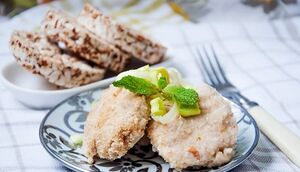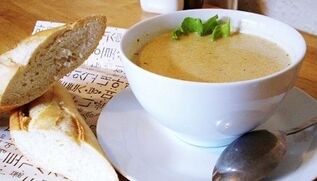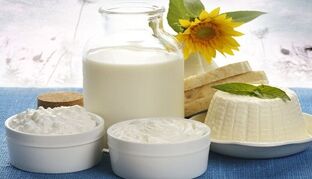
Pancreatitis is a serious pancreatic disease, characterized by a violation of the production of digestive enzymes. The main symptoms of the disease are pain after eating in the left or right hypochondrium, heartburn, nausea, vomiting, and abdominal discomfort.
Adhering to dietary guidelines is key to treating pancreatitis. After all, the development of the disease often occurs due to improper lifestyle, consumption of alcohol and "junk" food in large quantities.
Diet for pancreatitis helps patients to reduce pain syndrome during exacerbation of the disease and increase the degree of remission. In acute and chronic pancreatitis, the diet is different, but still has some similarities. Let's talk about them.
General dietary rules for pancreatitis
The main condition of the diet is to increase the amount of protein eaten and reduce fats and carbohydrates in the main food (if possible, it should be eliminated altogether) Especially you should stop the use of granulated sugar, as it consists of 99% carbohydrates.
Foods high in crude fiber will completely disappear from the lives of patients with pancreatitis. However, they put a strong burden on the pancreas, as a result of which the organ begins to produce large amounts of digestive enzymes, which are dangerous in this disease and can cause serious complications.
Doctors recommend that all patients with pancreatitis take vitamin complexes that will help replenish vitamin and mineral deficiencies in the body, often due to limited nutrition.

Meals should be scheduled at the same time.
Eat 5-6 times in small portions a day to avoid excessive pressure on the pancreas and overeating.
Diet for acute pancreatitis
As a rule, acute pancreatitis is manifested by sudden pain in the abdomen. The pain was unbearable, and therefore forced someone to call an emergency ambulance. The diet for acute pancreatitis before the arrival of the doctor is "zero". You can not eat food. Either "light" or "heavy".
Prior to the doctor's arrival, it is permissible to take non-carbonated mineral water, but not more than 3 glasses. And allowed to drink it only if the process of urination is normal.
Treatment of acute pancreatitis occurs only in a hospital setting. The first two days the patient is prescribed fasting. Only now is it allowed to drink rosehip broth along with mineral water. The amount of fluid consumed should not exceed 5 glasses a day.
On the third day of treatment, patients are allowed to eat fresh, low-calorie foods, which do not contain substances that cause irritation of the pancreas and increase the secretions produced.
After the main symptoms subside, the diet for pancreatic pancreatitis continues for one to two months. During this period, you should leave completely:
- fried and fatty foods;
- muffins and pastries;
- pickles and smoked foods;
- pickles and canned food;
- spicy and sweet;
- onions and garlic;
- alcoholic beverages;
- fatty meats and fish;
- sausage.
All food products must be treated with heat. They must be boiled in water or steamed. Do not use oil, salt and spices when cooking.

Patients are allowed to eat only warm and scarred foods. Before bed, it is recommended to use laxative fermentation milk products - kefir, fermented roasted milk.
Diet duration 6 to 12 months. This is how a person will abide by that his future health depends. If all dietary recommendations are ignored, the disease can become chronic and the patient should be treated for life.
Diet for chronic pancreatitis in remission
The diet of chronic pancreatitis is slightly different from the diet above. In this case, the patient's diet develops significantly, but only at the stage of remission. During the worsening period, the diet is completely different, but more on that later.
In chronic pancreatitis, protein intake is allowed, which may exceed a person's daily intake, as well as the consumption of carbohydrates (sugar, honey, toast, toast, etc. ) is allowed.
Foods that irritate the pancreas (hot spices, large amounts of salt, alcohol, etc. ) are the limitations.
The patient's diet should also be fractional. The amount of food is 4 to 6 times. The food served must be warm. You do not have to grind food before taking it.
Meat and fish products should not contain a lot of fat, otherwise they can cause liver degeneration, which often occurs in chronic pancreatitis. Cottage cheese contains many useful ingredients, and therefore must be present in the patient's diet. However, you can only eat homemade cottage cheese, but not too fatty. Save cottage cheese is forbidden to eat.
If a person cannot refuse bread, then he is recommended to use it while eating either pastry yesterday or crackers (only from gray or black bread). You can also eat baked goods and pastries, but in limited quantities (no more than one serving a day).
In case of pancreatitis, it is not recommended to drink milk in pure form, as it is poorly digested. It can be added to tea or made into cereals and soups. Although patients are tolerant of milk, it should not be taken in large amounts. The maximum dose is 200 ml.

Fermented dairy products are very useful for people with chronic pancreatitis. Even cheese, which at other stages of the disease is included in the list of forbidden foods, can be eaten in a calming state, but not in large quantities and provided you feel healthy. Cheese should not be too salty or fatty.
Eggs should not be eaten whole. Only egg whites are present in the patient's diet. It can be used to steam an omelet or add it to soups.
The patient's diet should not contain a lot of fat (no more than 70 g per day). Moreover, most should consist of vegetable fats. They are better digested and do not burden the pancreas.
Diet for chronic pancreatitis during exacerbations
Diet for pancreatic pancreatitis during exacerbations is similar to the acute form of the disease. The patient is prescribed to fast, and in the event of positive dynamics, he is allowed to eat fresh and low-fat foods in small amounts.
If there is no deterioration in health, the patient menu is gradually expanded. After 2-3 months, the person can eat in the same way as at the level of remission.
Remember, this is just a rough diet for pancreatitis. A complete list of allowed and prohibited products should be checked with your doctor. Only he can make the right diet, taking into account your state of health.















































































